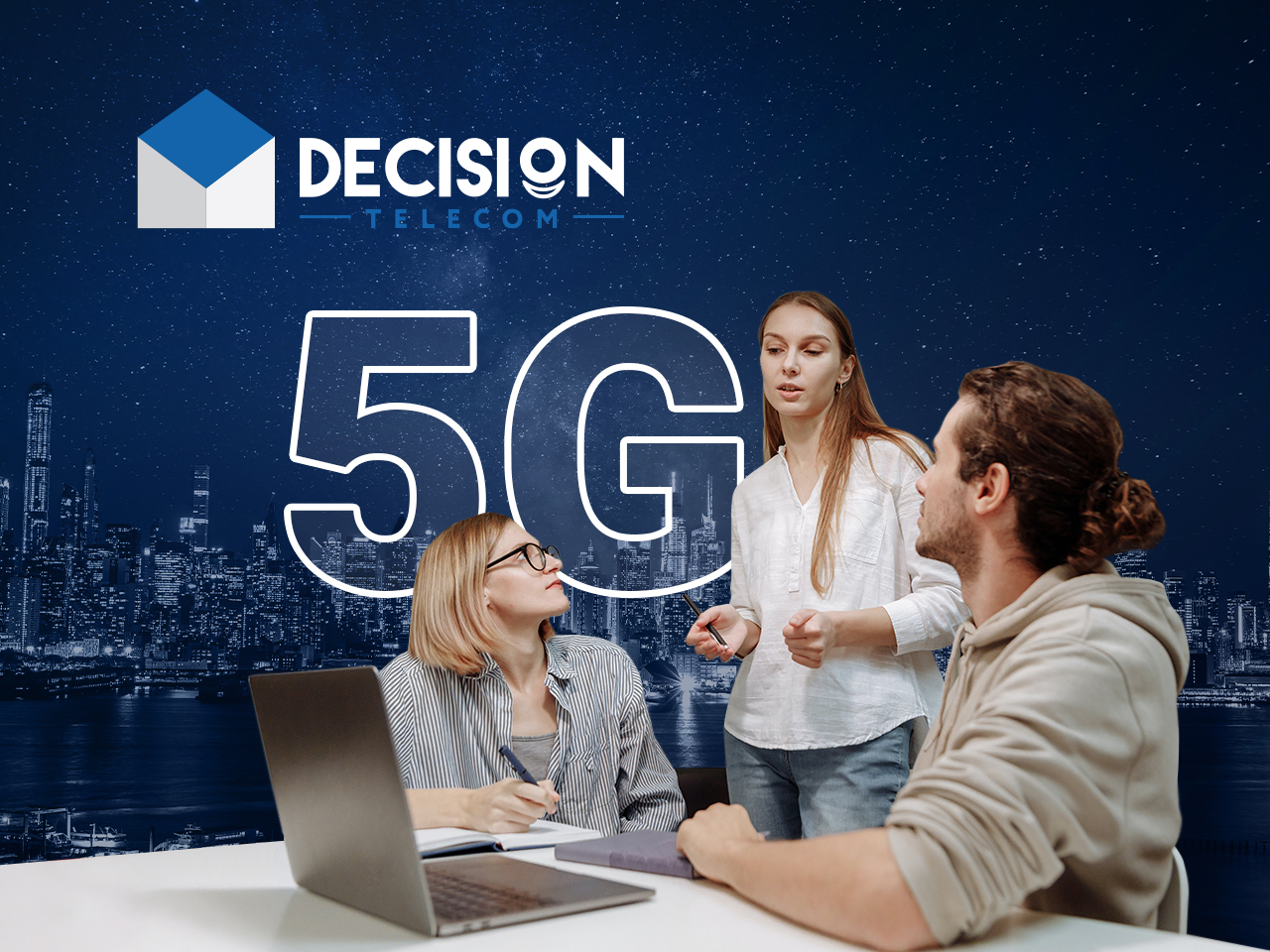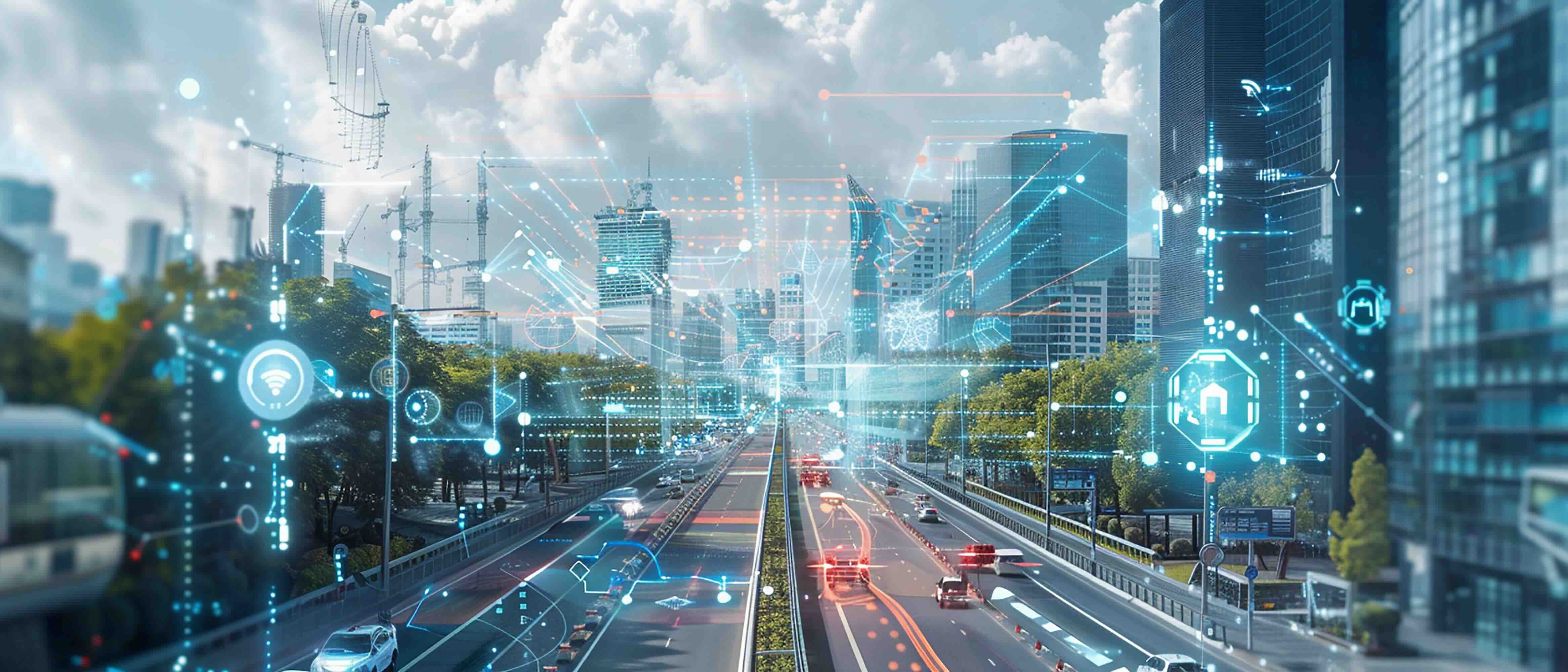
5G Implementation: Global Impact, Benefits, and Challenges
A modern mobile device is practically useless if you cannot make a call, send a message or access the Internet from it. All this is provided by a stable cellular network.
Until recently, four generations of networks were known to the global telecommunications industry: 1G, 2G, 3G, and 4G (LTE). However, the global telecom industry is now actively implementing 5G technology, the latest standard developed for wireless broadband digital communications.
In this article, we'll take a look at what 5G is, how it compares to previous generations, how it works, the global individual and business benefits it has resulted in, and the challenges faced in its implementation and adoption.
What is 5G?
The term 5G means the fifth generation of mobile networks. It is considered the latest development in cellular network technology, which follows the previous generations that are 1G, 2G, 3G, and 4G. Each of these generations brought significant improvements in speed, capacity, and capabilities, but 5G is seen as more than just a routine evolution.

It's more of a revolutionary leap forward in how wireless networks function, promising faster speeds, lower latency, and a greater ability to simultaneously connect more devices. With 5G, we are, therefore, entering an era where the mobile experience will be more immersive, more reliable, and more responsive, paving the way for innovations like autonomous vehicles, smart cities, and enhanced mobile broadband.
The difference between 5G and previous generations
To fully understand the significance of 5G, it’s essential to understand how it’s different from the previous four generations of mobile networks.
1G: First Generation
1G was the first generation of wireless communications, primarily focusing on voice services. It operated on analog signals, which had limitations in terms of quality and security. However, it was revolutionary for its time.
2G: Second Generation
With the advent of 2G, mobile phones transitioned from analog to digital, leading to way more secure and reliable voice calls. This generation also introduced SMS text messaging, which was a major milestone.
3G: Third Generation
3G marked the beginning of mobile internet usage, enabling faster data transfer rates and the ability to use multimedia services like video calls and mobile TV. However, its speeds and capacity were still limited by today’s standards.
4G: Fourth Generation
4G brought a significant increase in data speeds, making activities like video streaming, gaming, and real-time communication possible on mobile devices. It laid the foundation for the widespread adoption of smartphones and mobile apps. However, even with these advancements, there were still limitations in terms of latency and capacity.
5G: Fifth Generation
5G technology builds on the foundations of 4G but offers exponential improvements. The most notable differences include:
-
Faster speeds: 5G provides peak data rates up to 100 times faster than 4G, enabling ultra-high-definition video streaming and faster downloads. However, achieving these speeds requires the right conditions.
-
Low latency: 5G networks have significantly lower latency, reducing the delay in data transmission to nearly real-time, which is crucial for applications like autonomous vehicles and virtual reality. But this requires extensive infrastructure.
-
Increased bandwidth: With enhanced mobile broadband, 5G supports more devices in a given area, accommodating the growing number of connected devices in smart cities and homes. However, this also depends on network capacity.
-
Network slicing: 5G allows for the creation of private networks with tailored services, optimizing network capacity for specific use cases like emergency responders or industrial automation.
How 5G works
5G technology operates on new spectrum bands that were previously unavailable for commercial use. It uses a combination of low, mid, and high-frequency bands to provide a balance of coverage and capacity. Here’s a breakdown of how 5G works.

Spectrum bands
5G networks utilize three types of spectrum bands.
-
Low-band spectrum: Provides wide coverage but lower speeds. It is ideal for rural and suburban areas. However, speeds may not be as high as in other bands.
-
Mid-band spectrum: Offers a balance between coverage and speed, making it suitable for urban and suburban areas. But there are still limitations in densely populated areas.
-
High-band spectrum (mmWave): Provides the highest speeds but with limited coverage. It is used in densely populated urban areas and for specific use cases like stadiums and airports. However, it is more susceptible to interference.
Air interface
The 5G air interface, known as 5G NR (New Radio), is more flexible and efficient than its predecessors. It can adapt to different spectrum bands and support various use cases, from enhanced mobile broadband to ultra-reliable low-latency communications. However, it requires significant infrastructure to implement.
Cell towers
5G networks require a denser network of cell towers and small cells to provide the necessary coverage and capacity. Small cells are low-power base stations that can be installed on lampposts, buildings, and other structures to ensure a consistent 5G signal in urban areas. But there are challenges in finding suitable locations for these installations.
Network architecture
5G networks are built on a cloud-native, software-defined architecture, allowing for more flexibility and scalability. Network slicing is a key feature of 5G, enabling operators to create virtual networks with specific characteristics for different applications, such as low latency for autonomous vehicles or high reliability for mission-critical communications. However, managing these slices can be complex.
The impact of 5G on the global economy
The complete implementation of 5G is expected to have a transformative impact on the global economy. By enhancing mobile broadband and supporting the deployment of advanced technologies such as artificial intelligence (AI), edge computing, and the Internet of Things (IoT), 5G networks have enabled new business models and driven economic growth.
Job creation
The deployment of 5G networks will create millions of jobs worldwide, not just in telecommunications but across various industries, including manufacturing, healthcare, and retail. The need for skilled professionals to design, install, and maintain 5G infrastructure will, therefore, open up new career opportunities.
Economic growth
The increased efficiency and productivity brought about by 5G will contribute to global GDP growth. Sectors like manufacturing, logistics, and agriculture will benefit from automation and real-time data analytics, leading to cost savings and increased output. But these benefits will only be fully realized over time. By 2035, 5G is predicted to generate $13.2 trillion in economic value globally, according to a report on the impact of 5G published by PwC.
Innovation and startups
5G technology will foster innovation, providing a platform for startups to develop new products and services. The ability to transmit large amounts of data quickly and reliably will drive advancements in fields like virtual reality, augmented reality, and autonomous vehicles. However, competition has been – and will likely continue to be – fierce.
National security and competitiveness
Countries that have led in 5G implementation and especially incorporate it for their national security have surely gained a competitive edge in the global market. A robust 5G infrastructure is crucial for attracting foreign investment and enabling businesses to operate efficiently in a digital economy. However, the race to implement 5G has been challenging, with many more countries rapidly joining the race.
The impact of 5G on individuals
5G is not just a technological upgrade; it is meant to have a profound impact on our daily lives. As mobile network operators roll out 5G services, individuals have experienced improved mobile broadband, enhanced user experiences, and access to new applications that were previously unimaginable.
Enhanced user experiences
With 5G, mobile phones have become even more integral to our lives. Faster speeds and lower latency have made tasks like video streaming, online gaming, and video conferencing smoother and more enjoyable. The ability to connect multiple devices simultaneously has enhanced the user experience in smart homes, where everything from lighting to security systems can be controlled remotely. But there has been a learning curve for users.
Increased access to services by mobile network operators
5G networks will bridge the digital divide, providing high-speed internet access to rural and underserved areas. This increased access will enable more people to participate in the digital economy, access online education, and receive telehealth services. However, there may still be challenges in reaching the most remote areas.
Better connectivity on the go
For individuals on the move, 5G will keep providing more reliable connectivity, even in crowded urban areas or during large events. The enhanced network capacity of 5G will ensure that mobile broadband services remain fast and responsive, regardless of the number of users. However, it will take time to achieve full coverage.
Health and safety
5G technology will improve public safety by enabling real-time communication for emergency responders and providing critical information during disasters. The low latency of 5G networks will be essential for applications like remote surgery and autonomous vehicles, where every millisecond counts. However, these applications will require rigorous testing.
Usage of 5G technology
The use cases for 5G are vast and varied, spanning different sectors and applications. Some of the key areas where 5G will have a significant impact include the following.

Enhanced mobile broadband
Enhanced mobile broadband is one of the primary use cases for 5G, offering faster speeds and higher data rates. This will revolutionize the way we consume content on our mobile phones, from streaming high-definition videos to downloading large files in seconds. However, users will need compatible devices to fully benefit.
Critical communications
5G's low latency and high reliability make it ideal for mission-critical communications, such as those used by emergency responders, healthcare providers, and military operations. These applications require instantaneous data transmission and minimal delays. But the infrastructure must be robust.
The Internet of Things
The Internet of Things (IoT) will benefit greatly from 5G networks, as the increased bandwidth and network capacity will allow for the seamless connection of billions of devices. This will enable smart cities, where everything from traffic lights to waste management systems is connected and managed in real time. However, security will be a concern.
Autonomous vehicles
Autonomous vehicles rely on fast, reliable communication with other vehicles, infrastructure, and cloud services. 5G will provide the necessary low latency and high bandwidth to support these vehicles, making them safer and more efficient. But the technology is still in its early stages.
Smart factories
In smart factories, 5G will enable real-time monitoring and control of manufacturing processes. This will lead to increased efficiency, reduced downtime, and better quality control. However, it requires significant investment.
Smart cities
5G will be the backbone of smart cities, supporting a wide range of applications, from traffic management and energy distribution to public safety and environmental monitoring. The ability to connect thousands of devices and sensors in a city will enable more efficient and sustainable urban living. But there will be challenges in scaling these systems.
VR and AR
Virtual reality (VR) and augmented reality (AR) are poised to benefit immensely from 5G. The increased data rates and lower latency have already enabled more immersive and responsive experiences, whether for gaming, education, or professional training. However, the content must be developed further to take full advantage of these capabilities.
Edge computing
Edge computing, where data processing occurs closer to the source of data generation, will be significantly enhanced by 5G. This will reduce latency and improve the performance of applications like autonomous vehicles, industrial automation, and remote surgery. But the technology is still evolving.
How consumers use 5G
Consumers primarily use 5G for enhanced mobile broadband, allowing them to enjoy faster download speeds, smoother video streaming, and more responsive online gaming. The increased capacity of 5G networks will also enable more devices to be connected simultaneously, making it easier to manage smart homes and IoT devices. However, adoption rates vary.
How businesses use 5G
Businesses in many countries have leveraged 5G to improve productivity, streamline operations, and innovate new products and services. For example, manufacturing companies can use 5G for smart factories, where machines are connected and controlled in real time. Retailers can adopt 5G to enhance the customer experience, with personalized offers and faster checkout processes. However, such a transition requires careful planning.
The benefits of 5G for businesses
Increased connectivity
5G has interconnected more devices than ever before, from smartphones and tablets to IoT devices and smart appliances. This increased connectivity will drive innovation and enable new applications in smart cities, healthcare, and beyond. However, this also brings challenges in managing and securing these connections.
Better communication
The low latency and high bandwidth offered by 5G has enabled better communication, whether for video calls, online gaming, or remote work. The ability to transmit large amounts of data quickly and reliably has improved the quality of communication and reduce delays. However, the extent of this advantage depends on network conditions.
Improved productivity
5G enhances productivity by enabling real-time data analysis, automation, and remote work. Businesses can operate more efficiently, with faster decision-making and better resource management. However, the transition to 5G requires investment in new technologies and training, which may not be possible for many organizations.
Smaller physical footprint
5G technology requires smaller cell towers and equipment, reducing the physical footprint of network infrastructure. This has made it easier to deploy 5G networks in urban areas without disrupting the environment. However, there are still challenges in integrating these new installations with existing infrastructure.
Reduced rates of error
The low latency and high reliability can reduce the rates of error in applications like remote surgery, autonomous vehicles, and industrial automation. If implemented correctly, this can lead to safer and more efficient operations across various sectors.
High speed connection
According to the specifications declared by the developers, the 5G network is capable of reaching a maximum speed of up to 10 Gbps, which is 10 times faster than 4G speed. It’s almost lightning-fast, thanks to which users can access the internet faster, watch videos and listen to music on streaming services in the best quality. Downloading data and large files on a 5G network takes just a few seconds.
A study by HighSpeedInternet.com revealed that users will be able to save up to 24 hours per month on downloading and streaming internet data. Connection speed as a business benefit of 5G will allow companies to automate and expand the capabilities of video conferencing, corporate networks, and more.
Low response latency
Latency is the time from sending data/signal by a device to receiving it by the end user.
On average, 5G latency is 5ms, while 4G, for comparison, is 60ms. This means with the fifth-generation network, live broadcasts, broadcasts, stock trading, online video games, and virtual reality will be able to take place in fully real time, regardless of the location of the interlocutors.
Here, the advantage of 5G internet for business is the ability to increase the productivity of work processes and provide high security, for example, during payments and verification in banking.
Increased throughput
Throughput is user capacity, i.e., the ability to transfer a certain amount of data at maximum speed. Thanks to the upgrade to 5G, a network can simultaneously connect more devices per square kilometer without loss of speed and quality.
According to some estimates, the bandwidth of 5G technology is 10 times higher than that of 4G. This allows switching between cellular and Wi-Fi connections as needed without fear of losing connection due to high traffic.
Potential for new technologies
For businesses, 5G is an opportunity to deploy new technologies, applications, develop smart devices, create virtual worlds, and build smart cities. Self-driving cars are already available in the US thanks to the fifth generation of cellular networks. There is much more to come.
The challenges of 5G
While 5G offers many benefits, it also comes with numerous challenges that need to be addressed.
Health concerns
Some people have expressed concerns about the potential health effects of 5G radiation, particularly with the use of high-frequency bands. While studies have not found conclusive evidence of harm, ongoing research is needed to ensure that 5G networks are safe. Public perception still remains a challenge, though.
Economic impact
The deployment of 5G networks requires significant investment in infrastructure, which could strain the budgets of mobile network operators and result in higher costs for consumers. Additionally, the shift to 5G could disrupt industries that rely on older technologies, leading to job losses and economic challenges. Eventually, however, the long-term benefits are expected to outweigh these short-term impacts.
Privacy Risks
The increased connectivity and data collection enabled by 5G could lead to privacy concerns, particularly if personal data is not adequately protected. The use of 5G in smart cities and IoT applications will require robust privacy safeguards to prevent misuse of data. However, enforcing these safeguards will be challenging.
High costs for deployment
To fully reap the benefits of 5G for business, many businesses will need to completely retool their telecommunications infrastructure. This includes the purchase of new equipment, the modernization of technological processes, the opening of new licenses, the replenishment of the team with industry specialists, and the provision of services.
Thus, the development and deployment of the fifth-generation network will be expensive. Even if large companies can cope with the financial burden, most small enterprises are not ready to spend such a resource on the implementation of 5G.
Cyber security risks
This disadvantage is directly related to the high cost of deploying the technology in business. Since companies may try to save money while implementing 5G for business, such a system may be more vulnerable to hacking and become a target for scammers.
To mitigate risks, ensure that appropriate precautions have been taken during deployment and software is properly maintained and updated.
Network slicing
While network slicing offers many benefits, it also presents challenges in terms of management and security. Ensuring that each slice of the network is properly configured and protected will be essential for the success of 5G, which will require sophisticated technology and expertise.
Insufficiently developed infrastructure
Because the 5G specification requires higher frequencies, the network has a limited range. Trees and tall buildings impede wave propagation so more cell towers will be needed to achieve extensive coverage. To increase the throughput and improve the signal, sensors and additional antennas need to be installed on buildings and street objects.
Gaps in coverage
While 5G promises widespread reach, there are still gaps in coverage, particularly in rural and remote areas. Ensuring that everyone has access to 5G networks will require additional investment and collaboration between mobile network operators and governments. However, achieving full coverage will take time.
Rapid battery wear
When connected to 5G, the battery of any device wears out faster. As the network is more powerful, it has a greater effect on the battery and weakens the device. As 5G research and development continues, manufacturers are also looking for new ways to enhance the performance of reusable power sources.
Conclusion
5G is much more than high speed, fast response, and improved bandwidth. Taken together, this is a real opportunity for businesses to embark on a large-scale digital transformation.
The adoption of 5G technology in industry can lead to more flexible and efficient manufacturing operations while improving security levels. The creation of smart factories becomes possible thanks to automation, augmented reality and the Internet of Things (IoT). Widespread use of 5G IoT devices and sensors enables deeper integration of artificial intelligence into enterprise operations.
The introduction of 5G internet in business has contributed to more effective interaction through video communication, simplified video training and file sharing, improved customer service, and boosted workforce productivity and efficiency, among numerous benefits.


